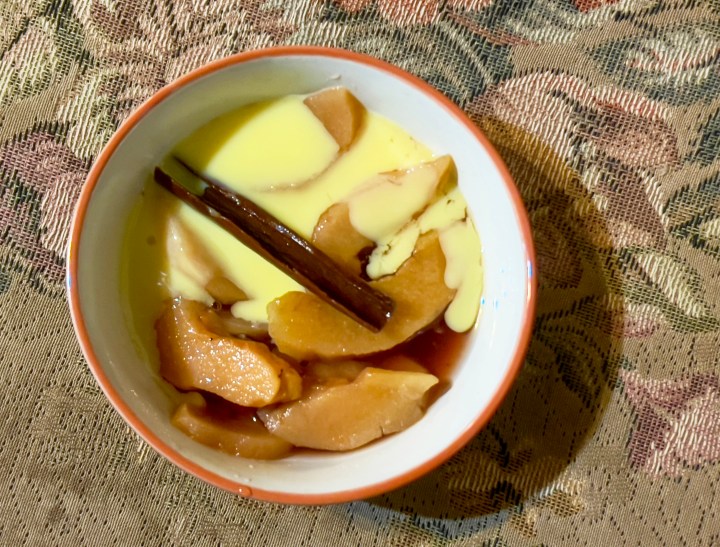WHAT’S COOKING
Throwback Thursday: The True Karoo joy of poached quince and custard

This was a true Karoo moment. Stepping into the back yard, picking quinces perfectly in season. Stepping back into the rustic old kitchen. And poaching them for a dessert as authentic as mosbolletjies and green fig preserve.
A quince is not so much Cinderella as one of her ugly sisters. As hard as a rock and no less appealing. But unlike her sisters, this fruit that is so unpleasing to the eye turns into the belle of the ball once she has been simmered in a sweet syrup. After some slow cooking, she turns out prettily pink, soft and most desirable.
But it must have been an intrepid soul who first picked a quince and thought, let’s boil them and see if they even begin to soften.
Picking quinces is a hit-and-miss affair. They may have started to rot on one side, and turned black, or you may spot some lying on the ground that have fallen, and when you turn them over find some nasty hidden secrets.
But I got lucky with a small haul of five decent-looking quinces in the back yard of the Boekehuis where I am nearing the end of a writing stint in Calvinia in the Hantam Karoo.
I took them in and started the process of turning the ugly sisters into the belles of the ball.
First they need a wash under running water to rub off the rough, furry coating they have. Then you need to peel them.
There’s no point in trying to core a quince. The black seedy core goes off in any direction it chooses, and might even be right below the skin in some places. Just slice them in half and take it from there, slicing out wedges as neatly as you can, and discarding anything that does not please the eye.
I chose to make a poaching syrup of water, soft brown sugar, lemon juice, cinnamon, green cardamom seeds, and dried lime leaves.
We ate the cooled quince with custard on the same day, but if you leave them in the poaching liquid for a week or two, refrigerated, they will turn gradually more pink as time goes by.
(Serves 4)
Ingredients
2 cups of quince slices, about 5 or 6 quinces
Juice of 1 lemon
4 cups water
250ml soft brown sugar
1 cinnamon quill
6 whole green cardamom pods
3 or 4 dried lime leaves or 2 fresh ones
Method
Peel the quinces as described above, after washing them, and cut into as many slim wedges as you can.
Put them in a deep, heavy pot with the water, sugar, cinnamon, cardamom and lime leaves, and squeeze in the lemon juice, through a colander or sieve, so that the pips don’t fall in.
Bring to a boil, stirring for the sugar to dissolve completely, then turn down the heat. Simmer gently, covered, until the wedges are soft and slightly pink.
Pour the water off into another saucepan, and reduce briskly until it is a lovely syrup. Leave to cool.
Serve the quince with a generous amount of the syrup and a little store-bought custard (or homemade custard if you prefer) poured over. DM
Tony Jackman is Galliova Food Writer 2023, jointly with TGIFood columnist Anna Trapido. Order his book, foodSTUFF, here.
Follow Tony Jackman on Instagram @tony_jackman_cooks.




I agree. Also love it mashed as a pretty pink compot.
Unfortunately it is a fruit which does not freeze well, poached quince somehow becomes both flabby and grainy at the same time.
Jam is good and also makes wonderful sweetmeats, if have the patience for hours long cooking. Jane Grigson has a very good recipe and method.
While reading Tony Jackman’s lovely article on picking and preparing poached quince to serve with custard my mouth started watering for this delicious dessert. It’s going on my shopping list immediately. It brought back memories of me as a little girl following my grandfather into his fruit orchard where he also had some quince trees. He taught me to eat raw quince: after scrubbing off the hairy fluff on the outside, he would take his penknife (grandfathers always had penknives in their pockets, didn’t they!) and chop a criss-cross pattern onto the hard flesh, sprinkle on some salt, then gave it to me to taste. I loved it and I have taught my grandchildren to do the same. And yes, I also have a penknife that I carry in my pocket wherever I go! You never know when you may come across a quince tree and an inquisitive grandchild, eager to try something new.